
Curator’s statement
In March 2025, I had the incredible opportunity to join a Hornbill Treks & Safaris FAM trip to Uganda. Our journey began in Kampala, followed by primate trekking in Kibale National Park, a safari in Queen Elizabeth National Park and gorilla trekking in Bwindi Impenetrable Forest. We wrapped up the trip back in Kampala. Hornbill, with their warm team, outstanding partner properties and expert driver-guides, delivered an unforgettable experience that had me eager to plan my next safari before I even left.
The Fora Difference
Book with Liz to access exclusive perks and experiences on your trip.
Killer perks
Free upgrades, spa credits and more—we got you
Personalized recs
Customized travel planning for your style
Insider knowledge
Expert advice from people who’ve actually been there
Where to stay in Uganda
Unlock perks by contacting Liz to book your trip.
Days 1–2: Journey to Kibale Forest – Entebbe & Kibale Forest National Park
After exploring the Ugandan capital, Kampala, our Hornbill guide met us early for the journey to Kibale Forest National Park. While many travelers fly, we chose the scenic 5-hour drive, passing through Fort Portal and Bunyaruguru Crater Lakes. The view of the lakes, surrounded by hills, was breathtaking, with Lake Nyinambuga featured on the 20,000 Ugandan shilling note. Green Leaf offers tours around the crater lakes, including canoeing and bird watching.
Kibale, known as the "Primate Capital of the World," is home to over 13 primate species, including chimpanzees and red colobus. We stayed at Primate Lodge, nestled in the forest next to the chimpanzee tracking start point. On arrival, we were greeted by a family of baboons crossing the road and fresh juice from the welcoming staff. Each cottage (banda) features high ceilings, a grass-thatched roof, mosquito nets, an en-suite bathroom with hot water and a private deck overlooking the forest. The lodge offers a personal butler who delivers fresh coffee or tea each morning. Meals are included, with daily-changing menus featuring international and African dishes, and many ingredients sourced from the lodge’s garden. Don’t forget to try the local Ugandan coffee!
Experience & Activities
We spent the day visiting local community projects, including a women’s weaving collective, a coffee farm and a small-batch roasting operation. We also enjoyed a guided nature walk through Bigodi Wetlands, home to over 200 bird species and eight primate species. These community-led initiatives support local education, clean water and healthcare efforts, allowing visitors to interact with local residents.
Day 2: Chimp Trekking in Kibale Forest National Park
The day began with a pre-trek briefing before we ventured into the forest for a two-to four-hour chimpanzee trek. We observed chimpanzees in their natural habitat as they swung from trees and interacted with one another. Trackers use signs in the forest to locate chimp communities. Once we found them, we spent an hour observing the chimps before returning to the park's headquarters. Afterward, I relaxed with a Nile River beer by the campfire before my butler escorted me back to my cottage for the night.
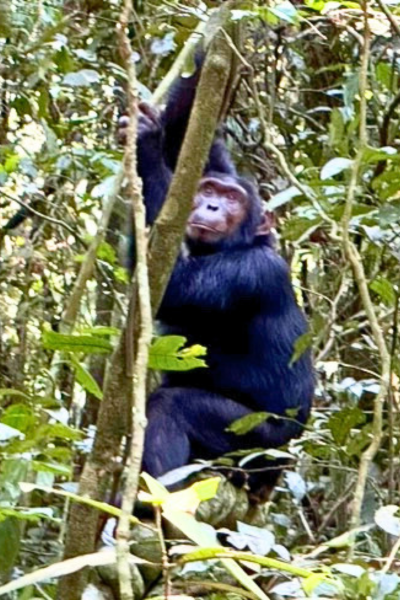
Chimp in Kibale National Forest
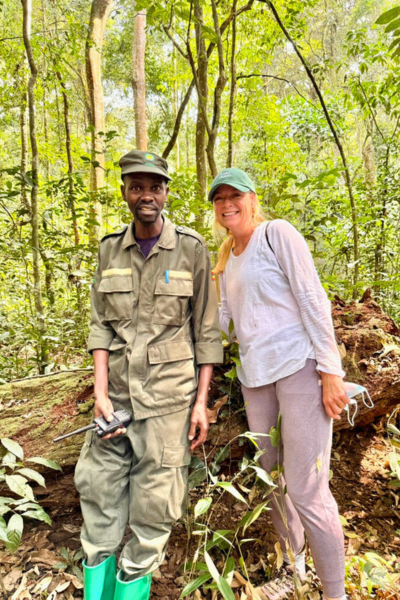
Chimp Trekker in Kibale National Forest
Days 3–4: Travel to Queen Elizabeth National Park
We began our scenic drive to Queen Elizabeth National Park, where we spotted elephants and birds along the way before settling in at Elephant Plains Lodge near the park entrance.
Day 5: Boat safari & game drive – Queen Elizabeth National Park & Kazinga Channel
After a sunrise breakfast, we embarked on a morning game drive where we spotted more elephants and a variety of birds, though the tree-climbing lions eluded us. A bush coffee stop allowed us to take in the beauty of the park.

Coffee Mama and me

Cheetah in Queen Elizabeth National Park
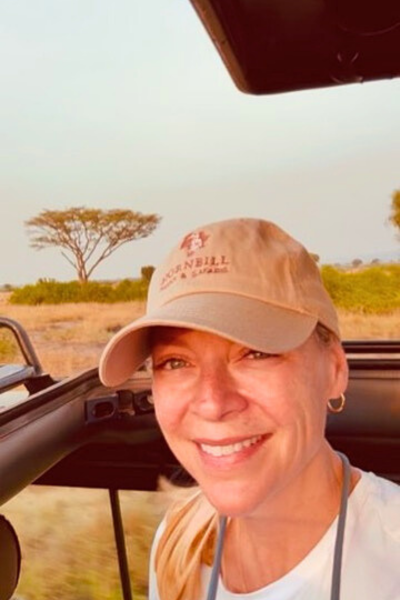
Game drive through Queen Elizabeth National Park
Later, we enjoyed a boat tour of the Kazinga Channel, where we observed birds, elephants swimming, crocodiles sunning themselves, and hippos resting in their pods. Being on the water and in the Channel provided a unique perspective on wildlife, distinct from the land-based view.
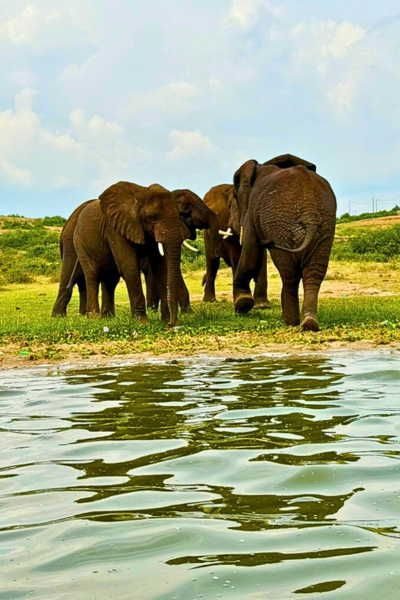
Elephants along Kazinga Channel
Day 6: Travel to Bwindi National Park via Ishasha Wilderness Area
Our scenic drive through the Ishasha Wilderness Area, a quiet region of Queen Elizabeth National Park, allowed for free-roaming animal migration. Along the way, we passed through local villages before arriving at Bwindi National Park.
Upon arrival, we visited the Ride4aWoman Center, a community initiative supporting over 300 women from nearby villages who have faced domestic violence, poverty and limited access to education. The center empowers women by teaching handicrafts, sewing and bicycle repair for local businesses.
Day 7: Gorilla Trekking in Bwindi's Impenetrable Forest
We were welcomed by the local community with traditional dances and a cultural introduction to Bwindi before our trek. After a briefing, we set off to find our assigned gorilla family. Each group of six to eight guests began on a marked trail, then ventured deeper into the forest. We spent an incredible hour observing over 10 gorillas in their natural habitat. Our rangers provided expert guidance, sharing insights into the gorillas' behavior and ensuring our safety. Even the most seasoned travelers found it a truly unforgettable experience.
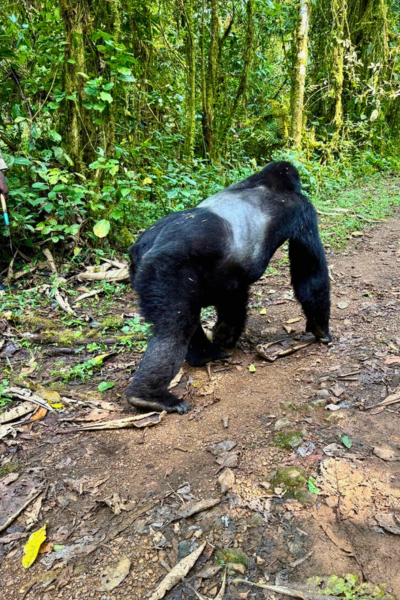
Silverback in Bwindi Impenetrable Forest
Day 8: Return Flight to Entebbe
On our final day, we boarded a 12-seater bush plane at Kihihi airstrip, enjoying the last views of the landscape below as we flew to Entebbe to catch our international flights home.

Volcanoes Bwindi Lodge River Overlook
Need to know
Things to Consider:
Lodge location matters — some are close to park entrances, while others require longer rides (which may be bumpy).
A safari that utilizes bush planes to travel between camps can reduce time spent in a vehicle, but it may also be more expensive and offer less opportunity to experience the local scenery and landscapes on the ground.
Types of Safari Accommodations are something else to consider when working with me to plan your safari are varying types of accommodations, including:
Traditional Hotels: Standard comfort with amenities like private bathrooms and air conditioning, but less nature immersion.
Individual Bandas: Private cottages with walls, windows and en-suite bathrooms, offering comfort and wilderness views.
Fixed Luxury Tents: Glamping-style tents with permanent structures and en-suite bathrooms, but no solid walls, for a nature-focused experience.
For more inspiration and insider recommendations, visit our Uganda page.

Travel Advisor
Liz Lee

Get in touch with Liz
Did you like this guide? Reach out to customize and book your own experience. Or, just to chat about travel in general.
You can expect a response from Liz within 1–2 business days. You’ll also be subscribed to our traveler newsletter (you can unsubscribe at any time).